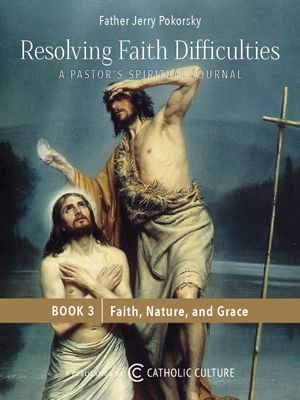We may not see, but there are no coincidences.
By Dr. Jeff Mirus ( bio - articles - email ) | Jul 26, 2012
Enjoying our time on the banks of Lake Champlain, but having to stay out of the rain today, my wife and I drove around the Lake into Vermont and then out onto the various islands accessed by Route 2. Eventually we ended up on Isle La Motte, where stands a large statue of Samuel de Champlain himself. Across the street from the statue is something far more important, St. Anne’s Shrine.
When the French settled the area in the seventeenth century, they put the region we now call Vermont under the patronage of St. Anne. As early as 1666 they erected both a fort and a chapel on Isle La Motte, in the middle of Lake Champlain. There Mass was celebrated by a Jesuit priest for the first known time in what is now the American Northeast. In 1668, the Bishop of Montreal visited Fort St. Anne to confirm a number of Indian converts.
Within a few years, both fort and chapel fell into disuse and ultimately into ruins. But the first Bishop of Vermont, who took office in 1853, had a fervent devotion to St. Anne which he fostered throughout his diocese. By 1886 a new parish was established which included Isle La Motte. The first parish priest did extensive research to preserve the spiritual history of the region, also marking out the site of the original chapel. This site was acquired by the diocese in 1892, and a new chapel was dedicated the following year, complete with a statue of St. Anne which still stands in the present chapel now.
From then on, it became a custom for Catholics in the surrounding region to take summer excursions to Isle La Motte, culminating in devotions at St. Anne’s Shrine, which in effect became a place of pilgrimage. The practice waxed and waned as demanded by the vagaries of war and shortages of the coal required to run the steamships across the Lake. Nonetheless, in 1904, the Shrine was entrusted to the Society of St. Edmund Fathers, who purchased it from the diocese in 1921, and who have made continuous improvements there, celebrating daily Mass and devotions on the site to this day.
And so Barbara and I found ourselves today as pilgrims at St. Anne’s Shrine, without even remembering at first that today is St. Anne’s feast (that is, the feast of Sts. Joachim and Anne, parents of the Virgin Mary). Barbara, who first remembered the feast, wondered what providential reason there might be for bringing us to this shrine on this day. We’re still not sure, but we prayed for everyone we could think of. For me, this included all those who use and support CatholicCulture.org.
We can’t always see the spiritual realities which connect the events of all our lives, but there are no coincidences. Everything is Providence. I reflected on this when I read the inscription beneath one of the statues at the Shrine: “St. Anne, mother and teacher, pray for us.”
And for everyone who reads these words. Amen.
All comments are moderated. To lighten our editing burden, only current donors are allowed to Sound Off. If you are a current donor, log in to see the comment form; otherwise please support our work, and Sound Off!









